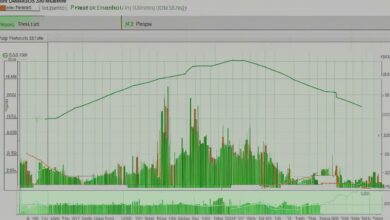Discussing Call Ratio Spread: Meaning and Examples

The Call Ratio Spread is an options trading strategy that can be utilized to potentially profit from a moderately bullish market outlook. This strategy involves buying options at lower strikes and simultaneously selling a higher number of options at higher strikes of the same underlying stock. It is commonly used when an option trader believes that the underlying asset will rise moderately in the near term only up to the sold strikes.
By implementing the Call Ratio Spread, traders can reduce upfront costs and potentially receive an upfront credit. The strategy is constructed by buying one In-the-Money (ITM) or At-the-Money (ATM) call option and simultaneously selling two Out-of-the-Money (OTM) call options of the same underlying asset. The market outlook for a Call Ratio Spread is moderately bullish with less volatility.
Key Takeaways:
- The Call Ratio Spread is an options trading strategy used to profit from a moderately bullish market outlook.
- It involves buying options at lower strikes and selling a higher number of options at higher strikes.
- This strategy helps reduce upfront costs and can potentially receive an upfront credit.
- It is constructed by buying one ITM/ATM call option and simultaneously selling two OTM call options of the same underlying asset.
- The market outlook for a Call Ratio Spread is moderately bullish with less volatility.
How to Construct a Call Ratio Spread
To construct a Call Ratio Spread, an options trader follows a specific strategy involving the purchase and sale of different strike options. The trader begins by buying one In-the-Money (ITM) or At-the-Money (ATM) call option and simultaneously selling two Out-of-the-Money (OTM) call options of the same underlying asset and expiry. The strike price can be customized based on the trader’s preference.
The primary objective of constructing a Call Ratio Spread is to take advantage of the trader’s belief that the underlying asset will rise moderately up to the sold strikes. By strategically selecting the strike prices, the trader aims to reduce upfront costs by receiving a credit or minimizing the premium paid.
When constructing a Call Ratio Spread, it is crucial to consider the concept of put-call parity. Put-call parity is a key principle in options trading that ensures the pricing relationship between put and call options. Additionally, the volatility of the underlying asset should be taken into account, as it can affect the overall performance of the strategy.
How to Construct a Call Ratio Spread:
- Buy one ITM/ATM call option
- Sell two OTM call options of the same underlying asset and expiry
- Customize strike prices based on preference
- Consider put-call parity and volatility of the underlying asset
By carefully constructing a Call Ratio Spread, options traders can capitalize on market opportunities, reduce costs, and manage risk effectively.
| Advantages | Disadvantages |
|---|---|
|
|
Example of a Call Ratio Spread
Let’s take an example to understand the Call Ratio Spread better. Suppose the current market price of NIFTY is 9300. An options trader believes that the price will rise to 9400 on expiry. They can enter a Call Ratio Spread by buying one lot of the 9300 call strike price at a premium of Rs 140 and simultaneously selling two lots of the 9400 call strike price at a premium of Rs 70. The net premium paid/received to initiate this trade is zero. The maximum profit in this example would be Rs 7500. For this strategy to be profitable, the underlying asset needs to expire at 9400. The trader should consider commission charges and manage risk through stop loss orders.
Credit Spread
A Call Ratio Spread can be considered a credit spread strategy, as the trader receives a credit when initiating the trade. In the example above, the premium received from selling two lots of the 9400 call strike price offsets the premium paid for buying one lot of the 9300 call strike price, resulting in a zero net premium. This credit received at the beginning of the trade helps reduce upfront costs and potentially enhances the overall profitability of the strategy.
Synthetic Positions and Risk Management
The Call Ratio Spread allows traders to create synthetic positions by combining multiple options contracts. In this example, the trader is effectively long one lot of the 9300 call strike and short two lots of the 9400 call strike. By combining these contracts, the trader can replicate the risk and reward characteristics of holding the underlying asset itself, but with reduced capital requirements.
However, it is important to note that the Call Ratio Spread carries unlimited risk. If the underlying asset’s price exceeds the higher breakeven point, the trader may face significant losses. To manage risk, implementing stop loss orders is crucial. Traders should set predetermined exit levels and be prepared to exit the trade if the underlying asset breaches these thresholds, in order to limit potential losses and protect their capital.
| Example Call Ratio Spread | Premium | Maximum Profit | Maximum Loss |
|---|---|---|---|
| Buy 1 lot 9300 call | $140 | Unlimited | Premium paid |
| Sell 2 lots 9400 call | $70 (each) | $7500 | Premium paid |
In the example above, the trader receives a zero net premium at the beginning of the trade. The maximum profit is capped at $7500, and the maximum loss is limited to the premium paid. Proper risk management practices and closely monitoring the trade are essential to successful execution of the Call Ratio Spread strategy.
Impact of Options Greeks on Call Ratio Spread
The Call Ratio Spread is a versatile options trading strategy that allows traders to generate potential profits from a moderately bullish market outlook. However, it is important to consider the impact of options Greeks on the strategy to make informed decisions and manage risk effectively.
Delta
The Delta of a Call Ratio Spread depends on whether the net premium is received or paid. If the net premium is received, the Delta would be negative, indicating that slight upside movement in the underlying asset would result in a loss. Conversely, if the net premium is paid, the Delta would be positive, requiring a significant upside movement in the underlying asset to incur a loss. Traders should closely monitor the Delta and adjust the strategy accordingly based on their market expectations and risk tolerance.
Vega
When it comes to Vega, the Call Ratio Spread has a negative impact. An increase in implied volatility would lead to a decrease in the value of the options, which can have a negative effect on the profitability of the strategy. Traders should factor in the volatility of the underlying asset and consider the potential impact of changes in implied volatility on their positions.
Theta
Theta measures the impact of time decay on options premiums. In the case of a Call Ratio Spread, Theta will have a positive impact on the strategy. As time passes, the option premiums erode, leading to a decrease in the overall value of the position. This can work in favor of traders who have received a net premium, as they can potentially profit from the decay of the options’ value over time.
Gamma
The Gamma of a Call Ratio Spread indicates its sensitivity to changes in the price of the underlying asset. This strategy has a short Gamma position, meaning that a significant upside movement in the underlying asset could impact the profitability of the position. Traders should be aware of the potential risks associated with large price swings and consider implementing risk management measures to protect their positions.
| Greek | Impact |
|---|---|
| Delta | Dependent on net premium received or paid |
| Vega | Negative impact |
| Theta | Positive impact |
| Gamma | Short Gamma position |
Risk Management in Call Ratio Spread
Effective risk management is essential when employing the Call Ratio Spread strategy in options trading. As with any investment strategy, it is crucial to protect capital and minimize potential losses. One key risk management tool that traders can utilize is the implementation of stop loss orders.
A stop loss order is a predetermined price level at which a trader will exit the trade to limit losses. By setting a stop loss order, traders can establish a maximum acceptable loss and automatically exit the trade if the underlying asset breaches the predetermined threshold. This helps to safeguard against significant losses and ensures that risk is managed effectively.
Traders should also consider the overall risk exposure of the Call Ratio Spread strategy. It is important to recognize that the Call Ratio Spread has unlimited risk if the underlying asset breaks the higher breakeven point. Therefore, it is crucial to carefully monitor the position and have a well-defined risk management plan in place.
Implementing risk management measures:
- Set strict stop loss orders to protect against excessive losses
- Establish a maximum acceptable loss for each trade
- Regularly monitor the position and adjust stop loss orders as necessary
By incorporating these risk management measures, traders can better navigate the potential risks associated with the Call Ratio Spread strategy and protect their capital investment.
| Risk Management in Call Ratio Spread |
|---|
| 1. Set strict stop loss orders to protect against excessive losses |
| 2. Establish a maximum acceptable loss for each trade |
| 3. Regularly monitor the position and adjust stop loss orders as necessary |
Advantages and Disadvantages of Call Ratio Spread
The Call Ratio Spread strategy offers several advantages for options traders. Firstly, it provides the potential to generate income from a moderately bullish market outlook. By buying one ITM/ATM call option and selling two OTM call options, traders can capitalize on their belief that the underlying asset will rise moderately up to the sold strikes. This strategy helps reduce upfront costs and has the potential to receive an upfront credit, making it an attractive choice for traders seeking to optimize their risk-reward ratio.
Another advantage of the Call Ratio Spread is that it allows traders to limit their risk of losses. By selling a higher number of options at higher strikes, traders can create a market-neutral position that provides some protection against adverse price movements. This can be particularly valuable in volatile markets, where the risk of losses can be higher. Additionally, implementing a Call Ratio Spread on the skewed side of the options market can enable traders to collect more premium, further enhancing their potential profitability.
However, it is essential to recognize the disadvantages and risks associated with the Call Ratio Spread strategy. One potential drawback is the possibility of losses if the liable premium is more than the receivable premium. Traders should carefully assess their risk tolerance and conduct a thorough cost-benefit analysis before executing a Call Ratio Spread. Furthermore, this strategy requires a high level of trading experience and understanding of market trends. It is important to stay updated on market conditions and adapt the strategy accordingly to maximize its potential profitability.
Advantages of Call Ratio Spread:
- Potential to generate income from a moderately bullish market outlook
- Reduces upfront costs and has the potential to receive an upfront credit
- Limits the risk of losses through a market-neutral position
- Opportunity to collect more premium on the skewed side of the options market
Disadvantages of Call Ratio Spread:
- Possible losses if the liable premium exceeds the receivable premium
- Requires a high level of trading experience and understanding of market trends
- Market conditions may affect the profitability of the strategy
It is important for options traders to conduct proper analysis and consider the underlying risks before executing a Call Ratio Spread. With the potential benefits of income generation and risk limitation, this strategy can be a valuable addition to a trader’s arsenal, provided it is implemented with caution and in line with market conditions.
| Advantages | Disadvantages |
|---|---|
| Potential to generate income from a moderately bullish market outlook | Possible losses if the liable premium exceeds the receivable premium |
| Reduces upfront costs and has the potential to receive an upfront credit | Requires a high level of trading experience and understanding of market trends |
| Limits the risk of losses through a market-neutral position | Market conditions may affect the profitability of the strategy |
| Opportunity to collect more premium on the skewed side of the options market |
Call Ratio Spread vs Put Ratio Spread
When it comes to options trading strategies, the Call Ratio Spread and Put Ratio Spread are two popular choices that cater to different market outlooks. While the Call Ratio Spread is used in anticipation of upward market trends, the Put Ratio Spread is designed for speculating downward market trends. By understanding the nuances of each strategy, traders can effectively navigate various market conditions and achieve their desired trading outcomes.
The Call Ratio Spread is a bullish trading strategy that involves buying one In-the-Money (ITM) or At-the-Money (ATM) call option and selling a higher number of Out-of-the-Money (OTM) call options of the same underlying asset. It is implemented when a trader believes that the underlying asset will rise moderately in the near term. On the other hand, the Put Ratio Spread is a bearish trading strategy that entails buying one In-the-Money (ITM) or At-the-Money (ATM) put option and selling a higher number of Out-of-the-Money (OTM) put options of the same underlying asset. It is used when a trader expects the underlying asset to decline in value.
Both the Call Ratio Spread and Put Ratio Spread involve the use of ratio spreads, which can help reduce upfront costs and manage risk. However, it’s important to note that the market outlook and direction differ between the two strategies. Traders should carefully analyze market conditions, conduct thorough research, and consider their risk tolerance before deciding which strategy to implement.
| Call Ratio Spread | Put Ratio Spread |
|---|---|
| Bullish strategy | Bearish strategy |
| Implemented when anticipating upward market trends | Used to speculate downward market trends |
| Buy one ITM/ATM call option and sell a higher number of OTM call options | Buy one ITM/ATM put option and sell a higher number of OTM put options |
| Reduces upfront costs and can potentially receive an upfront credit | Reduces upfront costs and can potentially receive an upfront credit |
| Market outlook is moderately bullish | Market outlook is bearish |
| Traders should believe that the underlying asset will rise moderately | Traders should anticipate a decline in the underlying asset |
In summary, the Call Ratio Spread and Put Ratio Spread are options trading strategies that cater to different market outlooks. The Call Ratio Spread is used when anticipating upward market trends, while the Put Ratio Spread is deployed to speculate downward market trends. By carefully analyzing market conditions and understanding the characteristics of each strategy, traders can make informed decisions and enhance their trading techniques.
Conclusion
The Call Ratio Spread is a versatile options trading strategy that allows traders to capitalize on a moderately bullish market outlook while managing risk. By constructing a market-neutral position through the purchase and sale of different strike options, traders can reduce upfront costs and potentially generate income. However, it is crucial to consider the impact of options Greeks and implement effective risk management measures.
When executing the Call Ratio Spread, traders should be aware of the Delta, Vega, Theta, and Gamma, as these options Greeks can significantly impact the strategy’s profitability. Additionally, strict risk management practices, such as setting stop loss orders and having a predetermined exit strategy, are essential to protect capital and avoid substantial losses.
The Call Ratio Spread can be adapted to different market conditions, making it a valuable trading technique. It offers traders the opportunity to enhance their trading skills and capitalize on market trends. By conducting thorough analysis and understanding market dynamics, traders can effectively utilize the Call Ratio Spread to their advantage, elevating their options trading strategies.
FAQ
What is a Call Ratio Spread?
A Call Ratio Spread is a premium neutral options trading strategy that involves buying options at lower strikes and selling a higher number of options at higher strikes of the same underlying stock.
When is a Call Ratio Spread used?
A Call Ratio Spread is used when an option trader believes that the underlying asset will rise moderately in the near term only up to the sold strikes.
How does a Call Ratio Spread help reduce upfront costs?
A Call Ratio Spread helps reduce upfront costs by buying one In-the-Money (ITM) or At-the-Money (ATM) call option and simultaneously selling two Out-of-the-Money (OTM) call options of the same underlying asset.
What is the market outlook for a Call Ratio Spread?
The market outlook for a Call Ratio Spread is moderately bullish with less volatility.
What are the breakeven points in a Call Ratio Spread?
The upper breakeven point is the difference between the long and short strikes plus the short call strikes +/- the premium received or paid, while the lower breakeven point is the strike price of the long call +/- the net premium paid or received.
How is a Call Ratio Spread constructed?
A Call Ratio Spread is constructed by buying one In-the-Money (ITM) or At-the-Money (ATM) call option and simultaneously selling two Out-of-the-Money (OTM) call options of the same underlying asset.
What is the maximum profit in a Call Ratio Spread?
The maximum profit in a Call Ratio Spread depends on the specific trade, but it can be calculated as the difference in strike prices minus the net premium paid or received.
What is the risk in a Call Ratio Spread?
The Call Ratio Spread has unlimited risk and limited reward.
How can risk be managed in a Call Ratio Spread?
Risk in a Call Ratio Spread can be managed by setting strict stop loss orders and having a predetermined exit strategy.
What are the advantages of a Call Ratio Spread?
The advantages of a Call Ratio Spread include the potential to generate income from a moderately bullish market outlook and limiting the risk of losses.
What is the difference between a Call Ratio Spread and a Put Ratio Spread?
The Call Ratio Spread is used for a bullish market outlook, while the Put Ratio Spread is used for a bearish market outlook.
How can the impact of options Greeks affect a Call Ratio Spread?
The impact of options Greeks, such as Delta, Vega, Theta, and Gamma, should be taken into account when constructing a Call Ratio Spread.







